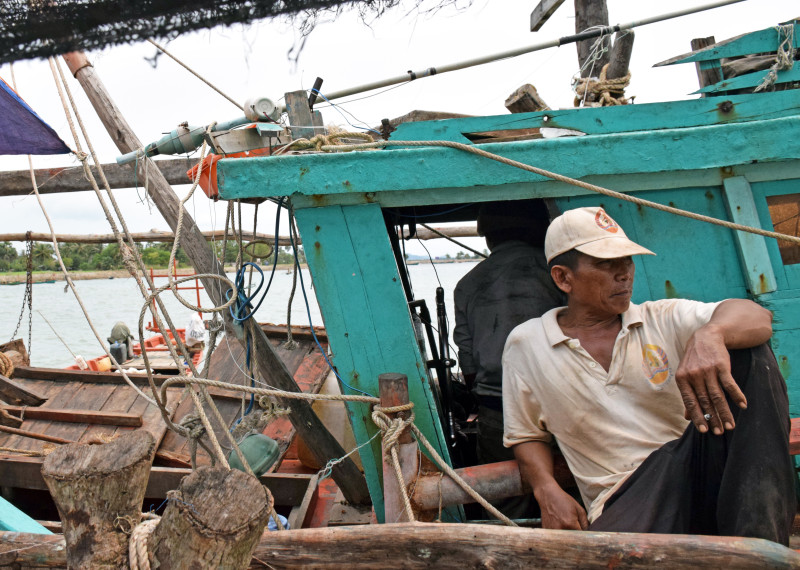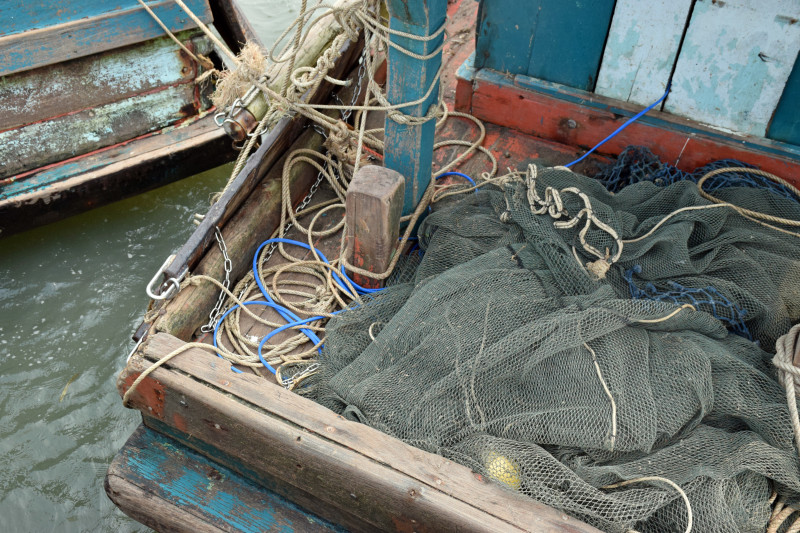KOH TONSAI PIER, Kep province – A dozen diesel-powered boats crawl across Kep Bay, creating a rumble so low that it shakes the pier. They drag weighted, electrified nets across the inshore shallows, scooping up sea life indiscriminately and destroying vital breeding grounds in the process. And they trawl so close to shore that you can hear their radio exchanges.
It’s a familiar, almost nightly, scene here. It causes nearly irreversible ecological destruction and creates tension between local fishing communities. And it is completely illegal, although authorities often turn a blind eye to it.

“Most of these boats fish between the mainland and Koh Tonsai,” Kong Yorn said on Thursday, nodding toward a fleet of about 30 trawlers moored to the pier he owns in the village of Prek Tanin, known locally as Phoum Chhok, or Shock Village, for its residents’ penchant for using electric currents to stun their catch.
“From here to Koh Tonsai, there is no water deeper than four meters,” he said.
Under Article 49 of the Fisheries Law, trawling inshore areas (those less than 20 meters deep) is forbidden. Under Article 20, using electric fishing gear is strictly prohibited in all areas. Both crimes are punishable by jail time, and authorities found to be complicit or willfully ignorant also face prison terms and fines.
But despite the regulations, fishing boats along Kep’s coastal strip continue to trawl the ocean unobstructed, many with electrified nets.
“The Fisheries Administration has no problem. They tell us that as long as we stay more than 1 km away from Koh Tonsai, even if it’s only four meters deep, we are able to fish,” Mr. Yorn said.
“They have never warned us otherwise.”
Now, as catches dwindle, the competition among fishermen here has never been fiercer. Clashes at sea are far from rare. In July, a Cambodian fisherman was killed in the waters off Kampot province during a standoff with a giant Vietnamese trawler that had ventured illegally across the maritime border.
And amid the mad rush, fishermen are increasingly using nets with tiny mesh and moving closer to the shore, scooping up juvenile fish—many of which end up discarded—and destroying the seagrass and shallow coral reefs that are the vital breeding grounds for marine life.
The electrified trawling nets scrape across the seabed, uprooting seagrass and indiscriminately stunning fish, crustaceans and other sea life such as sea cucumbers and starfish. The U.N.’s Food and Agriculture Organization has labeled bottom trawling the “most destructive” fishing method in the world, likening it to clear-cutting forest.
“Every time a trawler runs over an area, the ecosystem is completely destroyed and will not return for years,” said Matteo Krueger, a German biologist who has been conducting research in the Kep area since January.
“The ocean off Kep is, or was, like one giant nursery for sea life. But no longer.”
Mr. Krueger, whose research compares the state of Kep’s ocean ecology to that of Indonesia leading up to 1980, when a ban on trawling was issued and enforced, said that catches here are now just a fraction of what they were when trawling was introduced in 2000.
Indonesia began policing its oceans in time to see them flourish once more, he said. Cambodia might be running out of time.
“There used to be 13 species of marine mammal and five species of turtle here. Now they are all gone or endangered. The bycatch taken by trawlers can destroy the whole ecosystem,” he said.
“They are now getting only 25 percent of what they used to catch. For the fishermen to survive, something must change.”
At the end of a string of islands that stretches south from Kep to the maritime border with Vietnam, Marine Conservation Cambodia (MCC), in conjunction with the Fisheries Administration and Kep’s municipal government, is trying to nurture the area around Koh Seh back to health.
Extensive interviews with mainland fishing communities have found that unsustainable trawling by about 50 boats is a direct threat to the livelihoods of the other 1,500 families in the area that subsist by small-scale fishing, according to MCC director Paul Ferber.
“Eighty to 90 percent say that bottom trawling, with or without electricity, is the biggest problem,” he said. “Many small-scale fishermen are having to give up fishing and take up jobs in construction or security. They are having to move away from the area because there is nothing left to catch.”
MCC has worked to educate Kep’s fishing communities on sustainable fishing methods, as well as Cambodia’s Fisheries Law, particularly Article 49, which outlaws inshore trawling.
“Of all the fisheries laws, this is the most important and it seems to be the one that is most neglected,” Mr. Ferber said.
On the Prek Tanin pier on Thursday, Kong Hoeun repaired his trawling nets, which had mesh so fine that they would catch a marble. By his feet, a long electric cable was connected to copper wire running through the nets. The weather-beaten seaman scoffed at suggestions that his methods were illegal.

Like most fishermen interviewed, he had a two-pronged justification for his fishing practices: Authorities have never attempted to stop him, and he is competing with giant Vietnamese pair-trawlers that ply Cambodian waters with impunity.
“We have to fish for five hours just to catch what they catch in one hour,” he said. “We know that their boats are leaving us with less to catch, but what can we do?”
Maritime police have consistently denied the presence of foreign vessels in Cambodian waters, even attempting to write off the death of the Cambodian in the clash at sea as an accident. Fishermen, both Cambodian and Vietnamese, have claimed that police are paid off.
On Friday, Touch Poleak, deputy chief of the water border battalion, said he could “guarantee that no Vietnamese boats cross into Kep or Cambodian water.”
“Why would they need to fish in Kep? Kep is very small,” Brigadier General Poleak said.
Anyone reporting sightings of foreign vessels in Cambodia must be mistaken, he added.
While many in power seem to be allowing the problem of destructive fishing to fester, the Fisheries Administration’s Kampot cantonment, which also covers Kep, has made attempts to put itself on the right side of the law.
In June, alongside MCC, fisheries officers burned a giant mound of gear—nets, traps, electric cables—confiscated from illegal fishermen in the previous months.
Contacted on Friday, Kampot fisheries director Sao Sorin said that his men had remained vigilant on the water, and dismissed the claims of fishermen being permitted to operate illegally, such as in the shallow waters between the mainland and Koh Tonsai.
“We never allow that,” he said. “There are no trawling boats, only small boats using cast nets.”
Told that boats docked at Prek Tanin were equipped with electric cables, Mr. Sorin changed his tone, saying that he would visit the pier to search the trawlers. But he was less than confident that he could put an end to the illegal fishing methods that are destroying Kep’s ocean ecology and forcing people away from the only living they know.
“We will continue to inspect based on the information you have given us today,” he said.
“It’s true that we have a law, but the people have been fishing like this for a long time, so how are we supposed to stop it?”



